Lunar Phases and Their Influence on Surfing Conditions
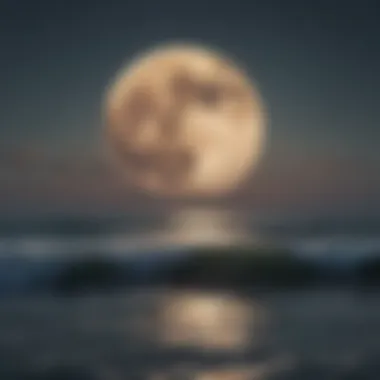
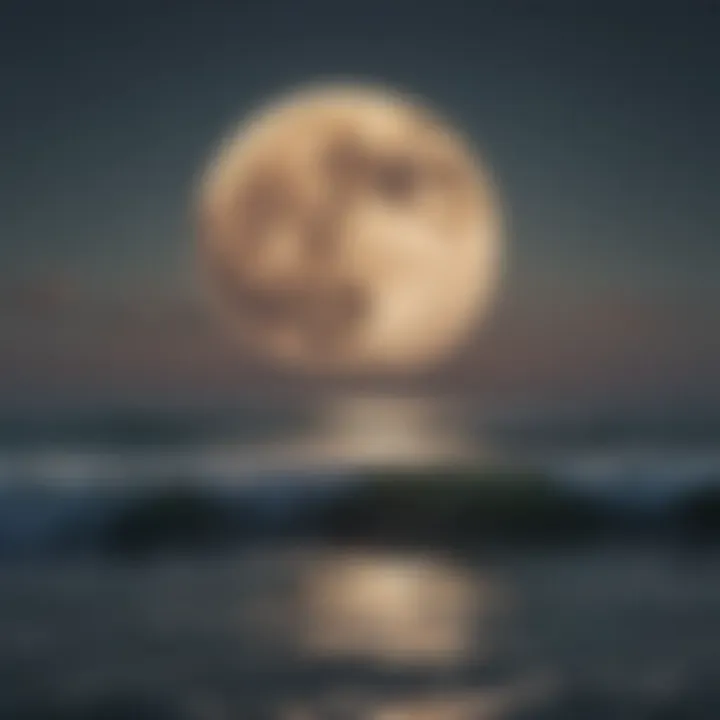
Intro
As the sun dips below the horizon and the day gives way to the cool embrace of evening, one might not think too much about that glowing orb hanging in the night sky. For surfers, however, that celestial body, often overlooked, plays a pivotal role in shaping their experience on the waves. The lunar phase from the previous night can have profound implications, influencing not just the tides but also the very fabric of surf conditions.
Understanding these relationships is not merely an academic pursuit; it’s about empowering surfers to optimize their ride. With a little knowledge of the moon’s effects, one can enhance their surfing endeavors, whether they are carving through the waves as a seasoned pro or just dipping their toes in the water for the first time.
This article dives into the significant aspects of lunar influences on surfing—drawing connections between the cycles of the moon and the rise and fall of ocean tides. We will examine how those shifting tides—possibly driven by yesterday's moon phase—affect wave quality and positioning in the water. Moreover, we aim to equip readers with actionable insights that can transform their time spent in the surf.
So buckle up, surfers and water enthusiasts alike; a deeper understanding of the night sky can lead to a more rewarding experience under the sun.
Lunar Phases Explained
Understanding lunar phases is crucial when considering their impact on surfing conditions. The relationship between the moon's position and ocean tides creates a rhythmic connection that surfers can leverage for better experiences. By grasping the cyclical nature of lunar phases, surfers can predict wave conditions, optimizing their time in the water. Here, we uncover the complexity of lunar cycles and how they intertwine with one's surfing endeavors.
The Cycle of the Moon
The moon follows a cycle of approximately 29.5 days, transitioning through various phases. Each phase brings unique characteristics that can influence tide levels and consequently surf conditions. It's a constant dance between the sun, the moon, and the Earth that governs high and low tides. As the moon travels around our planet, its gravitational pull creates the rhythmic ebb and flow of the ocean. This dance can significantly affect wave size and power, allowing surfers to find those sweet, glassy conditions.
Definitions of Moon Phases
Understanding specific moon phases is vital for comprehending their impact on surfing. Each phase comes with characteristic features that can sway surf conditions:
New Moon
The New Moon occurs when the moon is positioned between the Earth and the sun, making it invisible from our vantage point. With its gravitational influence, it contributes to the highest tides known as spring tides. For surfers, these robust tidal movements can lead to larger surfing swells and powerful waves. However, hiding beneath the surface, the surf breaks can also be unpredictable. Getting out during a new moon can be advantageous, but caution is always key.
First Quarter
As the moon shifts into the First Quarter, it becomes half-lit and rises high in the sky during the afternoon. This phase typically generates moderate tides, benefiting surfers looking for consistent wave action without the extreme swells. The characteristics of the wave height are often more manageable, enabling beginners and intermediate surfers to practice in safer conditions. Timing surf sessions during this phase can lead to pleasant surprises on the water.
Full Moon
The Full Moon shines bright, illuminating the night sky and maximally influencing tides. Similar to the new moon, this phase also brings spring tides, leading to significant wave action and bigger swells. Experienced surfers often relish this period, as it can produce exceptional conditions for catching waves. However, one must be wary; with great power comes unpredictability. The break can become aggressive, requiring skill and confidence to ride effectively.
Last Quarter
Finally, the Last Quarter phase sees the moon wane back to its half-lit state. This phase contributes to moderate tidal ranges, similar to the first quarter, which can translate into more manageable surf conditions. Surfers often find an opportunity for practice, especially those looking to refine their skills without the powerful waves seen during the full and new moon phases. Conditions during this time can be favorable for unique surf spots that may be less forgiving during stronger tides.
"The moon’s transitional phases not only shape the tides but also dictate the surf experience, making it crucial for surfers to pay attention to these celestial rhythms."
In summation, understanding the lunar phases equips surfers with a unique toolkit for planning and maximizing their surf sessions. Each phase serves as a key to unlocking different tidal phenomena, thereby informing decisions that can lead to a significantly enriched surfing experience.
Understanding Tides
Understanding the nature of tides is paramount for everyone who enjoys surfing. Tides, which are caused by the gravitational pull of the moon and sun, create waves that can vary in size and strength depending on their position and alignment in relation to Earth. This knowledge is especially crucial when planning surf sessions, as certain conditions can make or break your ride. Knowing what to expect can enhance a surfer's experience and help them choose the best times to hit the waves, thus optimizing their chances of catching good swells.
Tidal Mechanics
The Gravitational Pull
The gravitational influence of the moon is the primary driver behind the tidal phenomena we observe along coastlines worldwide. As the moon orbits Earth, it creates a bulge in the ocean waters closest to it due to its gravitational force. This phenomenon leads to what is known as high tide. Conversely, low tide occurs in areas where the water is drawn away, creating an ebbing effect.
You might think of this as the moon's own way of dancing with the Earth, pulling the water in a rhythmic pattern. The key characteristic here is the predictability of these tides; understanding this pattern can guide surfers when deciding on their surfing times. The unique feature of this gravitational pull is that it can shift significantly based on the moon's phase, particularly during full and new moons, leading to pronounced variations in tidal ranges which are beneficial for surfers looking for optimal conditions.
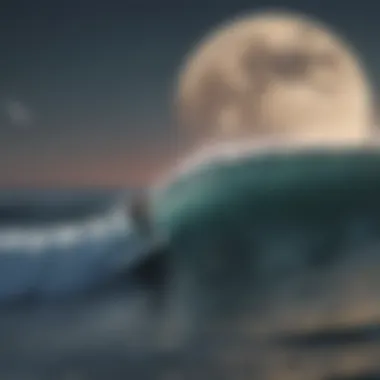
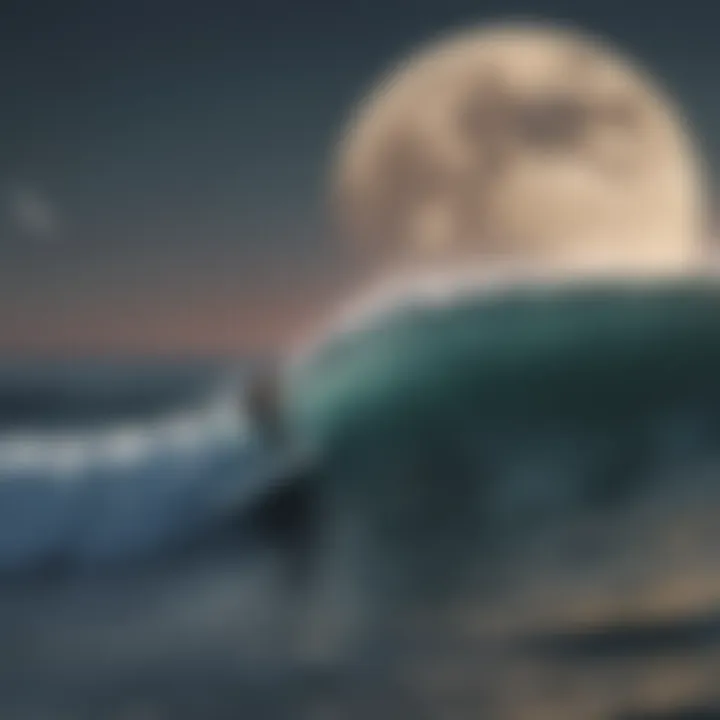
Spring and Neap Tides
Spring and neap tides are essential concepts every surfer should be acquainted with. This aspect ties the moon's phases directly into tidal behavior. During spring tides, which occur around the full moon and new moon phases, the sun and moon's gravitational forces align, resulting in higher high tides and lower low tides. This means greater tidal ranges that can contribute to larger swells.
On the flip side, neap tides occur roughly a week after spring tides, during the first and last quarter phases of the moon. Here, the tides are less extreme, with lower high tides and higher low tides. It’s important to recognize that while spring tides can yield larger surf, neap tides often offer a steadier, more manageable surf experience—ideal for beginners. Considering both spring and neap tides enables surfers to anticipate and plan their outings more effectively.
Tide Tables and Predictions
A well-prepared surfer will always have a look at the tide tables and predictions before hitting the ocean. These tables provide crucial information, detailing when high and low tides will occur, their expected heights, and how these will correspond with local surfing conditions. Accessible via various websites or even local surf shops, these resources can often make the difference between a mediocre session and a delightful day on the waves.
It's also worth noting that weather conditions, such as wind patterns, can influence tidal behavior as well, leading to additional considerations for those eager to ride the surf.
Ultimately, understanding tides is not just about knowing when to surf but also about predicting how these natural forces will interact with the waves, enabling surfers to make informed decisions to enhance their experience.
How Moon Phases Affect Ocean Tides
Understanding how moon phases influence ocean tides is crucial for surfers looking to maximize their wave-riding experience. The gravitational forces exerted by the moon not only control the ebb and flow of the tide but also have a considerable impact on wave behavior. This section presents a detailed examination of the connection between these lunar phases and tidal patterns, offering insights that can help surfers pick better times and spots for their sessions.
Connection Between Moon Phases and Tides
The pull of the moon isn't just for romantic moonlit strolls; it plays a significant role in the world’s oceans. As the moon transitions through its various phases—new, first quarter, full, and last quarter—its gravitational influence tugs on the water, creating higher and lower tides.
- New Moon and Full Moon: These phases are characterized by the sun, moon, and Earth being in alignment. This alignment results in spring tides, which are the highest and lowest tides. For surfers, spring tides can bring larger swells, creating ideal conditions for some exhilarating rides.
- First and Last Quarter Moons: The sun, moon, and Earth form a right angle during these phases, leading to neap tides. These tides are lower than average. While less dramatic than spring tides, neap tides can still provide favorable conditions, especially for beginners.
Understanding these variations allows surfers to plan their sessions based on tidal height, ensuring the best possible conditions for catching waves.
Lunar Cycles and Their Influence
Increased Swell Size
When considering the impact of moon phases, one cannot overlook the increased swell size that often arises during spring tides. As the moon's gravitational pull intensifies, it can generate a notable increase in ocean swell, something that seasoned surfers eagerly anticipate.
- This swell plays a key role in shaping the surf experience, particularly during periods of higher tide. When swell size peaks, surfers can enjoy more powerful waves that offer thrilling challenges.
- That said, larger swells can be quite demanding. Only experienced surfers should tackle swells that are heavily influenced by these spring tides, as they can lead to more challenging and potentially dangerous conditions.
Moreover, one can describe the swell's unique feature as something that opens up the ocean, creating larger breaking waves along the reefs and points, which often means a more exhilarating ride for those who seek adventure and excitement in their surfing.
Shifts in Wave Patterns
Another aspect worth discussing is shifts in wave patterns triggered by the tidal changes linked with moon phases. As tidal flows change, the behavior of waves also evolves, which can result in various surfing conditions.
- Surfers often find that during a high tide, waves might behave differently compared to low tide. High tide can bring in more uniform conditions, ideal for longboarders, while low tide produces faster, more hollow waves that shortboarders typically favor.
- The unique feature here is that these shifts can lead to different types of surf breaks becoming more or less favorable. Certain spots that are usually excellent at low tide might become challenging during high tide, and vice versa.
For surfers, understanding these changes allows them to identify the best places to hit the waves based on local conditions. By being attuned to how moon phases influence not just the tides but also the very rhythm of the ocean, surfers position themselves to elevate their riding experience.
"The moon is a vital companion to the ocean, and for surfers, understanding its dance can lead to an unmatched experience on the waves."
In summary, recognizing how the moon phases influence ocean tides offers a wealth of information for surfers. It helps plan not only the timing of surf sessions but also the select beaches to visit based on the unique characteristics of each phase.
The Moon Phase of Last Night
Understanding the moon's phase from the previous night has significance that stretches beyond mere observation; it allows surfers to anticipate conditions on the water. With every phase, the moon exerts varying gravitational influences, affecting tides and subsequently surf conditions. Knowing this can translate into practical benefits, such as timing sessions to catch the best waves or steering clear of choppy waters. Engage deeply with the moon phase, and it can become a guiding light in your surfing routine.
Identifying the Moon Phase
Astronomical Data
Astronomical data serves as a cornerstone for identifying the moon phase effectively, offering precise details about lunar cycles. These data sets are derived from various organizations that track celestial movements, providing evidence-based insights into the moon's current stage. The clarity associated with astronomical data makes it a preferred choice for many surfers who prefer not to delve into guesswork. A unique feature of this data is its reliability; it ensures that surfers aren’t left in the dark about the lunar influence on their nearby surf spots. However, it can be somewhat complex to interpret, particularly for those not well-versed in astronomy or meteorology.

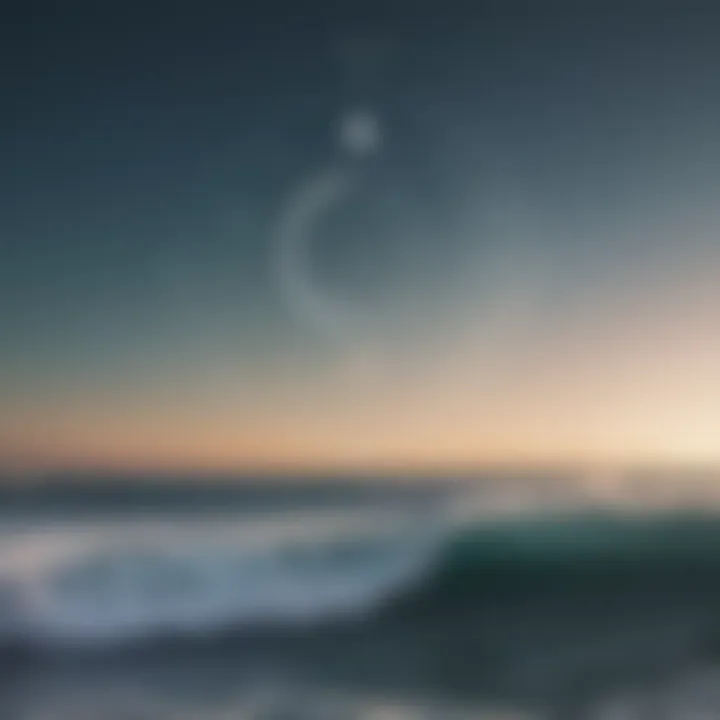
Local Observations
When it comes to identifying the moon’s phase, local observations provide a practical, hands-on approach. By simply looking up at the night sky, surfers can spot the moon and determine its phase. This offers a sense of connection to the environment that data alone cannot provide. Local observations emphasize intuition gained through experience, which can be quite beneficial for surfers developing their skills. The downside? You might overlook finer details captured in more scientifically rigorous approaches, such as subtle tide shifts dictated by astronomical data.
Possible Effects on Surf Conditions
Wave Height Variations
The moon phase directly influences wave height variations, a key factor every surfer should consider before hitting the waves. During the full moon and new moon, the gravitational pull is at its strongest, often leading to larger swells and increased wave energy. This characteristic presents an exciting opportunity for surfers searching for that exhilarating ride. Nonetheless, this increased power can also pose risks for less experienced surfers, as higher waves mean stronger currents and potential hazards.
Tidal Changes
Tidal changes, intricately linked to the moon’s cycles, present both challenges and opportunities for surfers. When the moon is full or new, the tides tend to experience larger fluctuations, which can create optimal surf conditions during certain times. Surf spots that are typically flat during regular phases might swell to life during these peaks. Yet, it’s essential for surfers to be mindful of how these changes might affect local reefs or shorebreaks, as higher tides can lead to unexpectedly dangerous conditions or even closures of certain beaches due to safety concerns.
Optimizing Surfing Experience
To truly get the most out of your time in the water, it’s essential to optimize your surfing experience. This is about understanding that not all sessions are created equal. The lunar cycle, as described before, plays a pivotal role in determining surf conditions. By timing your sessions and choosing the right spots, surfers can harness the natural forces at work. This approach can significantly enhance both the performance of the waves and the enjoyment of riding them.
Timing Your Surf Sessions
Best Times to Surf During Different Phases
When it comes to the best times to surf, understanding lunar phases can be a game changer. Each phase brings its own charm, affecting swell size, wave shape, and ultimately the quality of your ride. For instance, surfers often find that the days surrounding a full moon can produce larger and more powerful swells, making it a prime time to hit the beach.
During these times, the gravitational pull of the moon peaks, creating more significant tidal movements. The uniqueness of this phase can lead to ideal surfing conditions, especially during early mornings or late afternoons when the winds tend to be lighter.
However, keep in mind that not every full moon brings perfect waves. It’s crucial to scout your local surf breaks and familiarize yourself with how the moon’s cycle consistently affects them. This intuitive awareness allows surfers to plan and choose the best time, ensuring they don’t waste precious hours waiting for the right conditions.
Interpreting Tide Charts
Understanding tide charts can feel daunting at first, but their importance cannot be overstated. These charts indicate the times when tides are high or low, directly correlating with surf quality. Typically, the best surfing occurs during rising tides which fill the sandbars better, creating peaky waves that are easier and more fun to ride.
The real beauty of tide charts lies in their ability to guide you. They show predicted high and low tides, helping surfers to pin down when to paddle out. While tide charts are generally reliable, local conditions can sometimes lead to variations. This means that knowing your spot’s unique characteristics, coupled with the tide charts, gives surfers a solid edge.
Choosing Surf Spots
Location Considerations
Location truly matters. Not every beach is created equal with respect to lunar influences. Some spots might get blown out easily with wind, while others may remain glassy. When picking a surf spot, it’s vital to consider both the geographical features of the beach and your skill level. Popular surf towns often see a competition for the best waves, making it essential to arrive at times when both tidal conditions and crowds are favorable.
It’s important to research local breaks that cater to various moon phases. For instance, a reef break might benefit more from a spring tide compared to a beach break. This strategic thinking not only saves you time but also enhances your surfing experience by allowing you to choose the location that suits the day’s conditions best.
Environmental Factors
Environmental factors also play a significant role in enhancing one’s surfing experience. These factors can include wind speed and direction, water temperature, and even marine life activity. Wind, for example, can either work for or against surfers; offshore winds usually create cleaner faces, while onshore winds can cause choppy conditions.
Moreover, moon phases can influence marine life activity as well, leading to variable conditions. A rise in certain fish or plankton could signal good (or troublesome) conditions in the surf. Thus, taking all these factors into account often leads to more rewarding surfing experiences, with fewer surprises out in the lineup.
Knowing all these elements helps surfers not be just reactive but proactive in their surfing adventures. This foresight can mean scoring cleaner, more powerful waves with each outing.
In summary, optimizing your surfing experience hinges on understanding the interaction between lunar phases, tides, and environmental factors. By paying close attention to these aspects, surfers can elevate their time in the water and truly connect with the ocean.

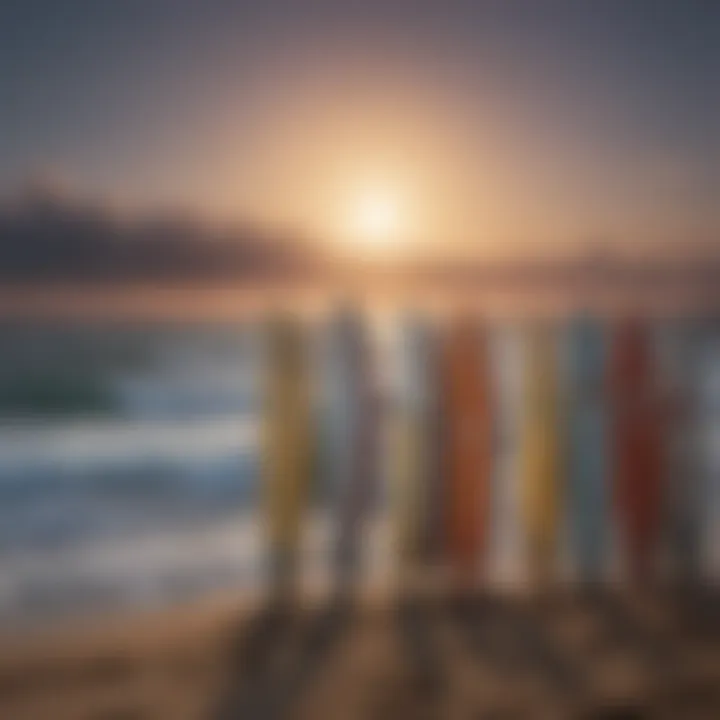
The Role of Weather Conditions
Weather plays a pivotal role in the surfing experience. It's not just about the waves and tides; the conditions in the atmosphere greatly influence the overall surfability of a session. Diving into details of these elements unravels a layer of complexity that can make or break a surf adventure.
From the temperatures of the sea to the patterns formed by the wind and the brewing storms, every aspect interwinds with the lunar impact we’ve already discussed. Combined, these factors create an environment that can either uplift or hinder your time in the surf. Understanding these dynamics allows surfers to anticipate and adapt to conditions, ensuring they catch the best waves possible.
The Impact of Wind and Storm Patterns
When we think about waves, wind often takes center stage. On any given day, the wind can be the silent partner that subtly manipulates wave shape, size, and consistency. The direction, speed, and temperature of the wind matter significantly. Here are some key points to consider:
- Offshore Winds: Usually a surfer’s best friend, offshore winds blow from the land towards the sea, grooming wave faces and allowing for cleaner rides. This condition often happens during the late afternoon when water and air temperatures stabilize, often after heated midday conditions.
- Onshore Winds: In contrast, onshore winds, coming from the ocean towards the land can create choppy waters and less enjoyable surfing experiences. Surfers might have to adapt and look for breaks that withstand these gusts better than others.
- Storm Patterns: Storm cells can create swells that drastically enhance surf conditions hours, or even days after they pass through. Anticipating surf after a storm can reward surfers with bigger, more powerful waves. However, it is also important to note that storms can make conditions dangerous, requiring skill and caution.
"Understanding wind patterns is akin to reading a book—every great surfer must learn its language to ride the ultimate tides."
Forecasting for Optimal Surfing
Making the most of any surf outing relies on solid forecasting skills. While no one can truly conquer the whims of the weather, being abreast of patterns and predictions provides surfers with a clear edge. Here’s how to optimize your surf sessions:
- Utilizing Weather Apps: Leverage modern technology by regularly checking reliable weather forecasts via dedicated surfing apps and websites. Look for wind speed and direction, tide conditions, and wave forecasts.
- Observe Local Conditions: Nature often provides cues worth paying attention to. Observing the ocean early in the day can reveal shifts in wave activity and current conditions that might not be reflected in digital predictions.
- Community Input: Engage with local surfers or adventurous communities on platforms like Reddit for real-time insights. These surfers often share valuable intel about changes in conditions that might not be captured in formal forecasts.
- Adaptability is Key: Be ready to change your plans based on weather developments. Sometimes, what appears to be a bleak day can surprise with unexpected surfable waves.
Sustainable Practices in Surfing
Surfing isn't just about catching the perfect wave; it's also about respecting and protecting the delicate ecosystems surrounding our favorite spots. Therefore, adopting sustainable practices in surfing has never been more critical. The surfing community holds a unique position that can either contribute to or mitigate environmental impacts, making it essential for surfers to be informed and proactive.
By understanding how tides and lunar phases influence marine life and coastal environments, surfers can better appreciate their role in maintaining these natural systems. The tides, influenced by the moon's gravitational pull, play a crucial part in the health of beach habitats. For instance, during full moons, the higher tides can lead to extensive erosion of coastal areas or can alter the sediment beds, affecting local wildlife. Thus, the behavior of the ocean is intricately connected to lunar influences. By implementing eco-conscious habits, surfers can help preserve these vital areas.
Considering Environmental Impact of Tides
Every time a surfer heads out, the impact of their actions resonates through the environment. Much like how a ripple extends outward from a stone tossed into the water, our habits can disturb or enhance the ecosystems that surround us. Here are some important considerations:
- Erosion and Habitat Disruption: High tides, especially during specific moon phases, can reshape shorelines. Recognizing this helps surfers understand how their favorite spots can evolve.
- Wildlife Interference: Surfing spots might often coincide with marine wildlife habitats. Being conscious of seasonal migrations, such as sea turtles nesting or fish spawning seasons, means less disturbance to natural cycles.
- Pollution and Water Quality: Proper waste disposal enhances water quality. Conditions after heavy rain are often not suitable for surfing, as contaminants from land runoff can pose health risks.
Surfers have the chance to be stewards of the sea. Supporting local clean-up initiatives or participating in monitoring tides provides meaningful contributions to the health of coastal regions.
Eco-Conscious Surfing Habits
With the drive towards sustainability gaining momentum, the surfing community can embrace various eco-friendly habits. Making conscious decisions isn't just responsible; it's essential for the longevity of the sport. Here are some effective habits to integrate into your surfing routine:
- Choose Sustainable Gear: Opt for surfboards made from recycled materials or those crafted with an emphasis on sustainability. Brands like Firewire and Greenlight offer eco-friendly alternatives that do not compromise performance.
- Be Mindful of Your Impact: Avoid surfing in areas where wildlife is vulnerable. Knowledge about local ecosystems helps surfers make informed choices about where to ride the waves.
- Utilize Eco-Friendly Products: Selecting biodegradable wax and other surf accessories minimizes pollution. Likewise, many companies produce surf apparel using sustainable practices.
- Practice Leave No Trace: Always pack out what you take in. The mantra of leaving the beach cleaner than you found it should be prioritized. Investing in a reusable water bottle, for instance, significantly cuts down on single-use plastics.
- Advocate for Coastal Health: Engaging with local environmental organizations amplifies awareness about crucial ocean issues, paving the way for collective action within the surfing community.
In the end, integrating sustainable practices into surfing isn’t just a trend; it's a vital aspect of our responsibility as surfers to preserve the environments we cherish. By doing so, we ensure the waves will be waiting for generations to come.
Culmination
Understanding the interaction between lunar phases and surfing is pivotal for anyone drawn to the shore, from seasoned wave riders to curious novices. The ties between the moon and ocean tides can’t be overstated; they dictate not just the rise and fall of the water, but also how the waves perform across different surf spots. Even as the forces of nature create a complex symphony, recognizing the components of this connection allows surfers to harness their sport's nuances for a more enjoyable experience.
Summary of Insights
- Lunar Phases and Tides: Each moon phase contributes significantly to the tides we see at the beach. A full moon, for instance, leads to higher and more powerful tides, resulting in waves that can challenge even the most skilled surfers.
- Last Night's Moon: By evaluating the conditions stemming from the previous night’s lunar position, surfers can predict how the surf might behave today. Understanding whether it was a new moon, first quarter, or full moon, can dramatically shift one’s approach to choosing surf times or locations.
- Weather Interactions: The weather also plays a crucial role. For instance, the wind's direction and intensity can change the game entirely. Pair this information with moon data to finely tune one’s surfing strategy.
- Environmental Impact: Surfers must remain mindful of their ecological footprint. Knowing how tides influenced by moon phases affect shorelines and marine habitats can foster a more sustainable surfing practice. This means not just riding the perfect wave, but protecting the environment that allows for the ride in the first place.
As a surfer, equipping oneself with this knowledge can lead not just to better rides but also to a deeper respect for nature’s rhythms. Being aware of how the moon influences the surf can make all the difference in your next session and shape your experience on the water for the better.
Encouragement for Further Exploration
With the tides constantly shifting and the moon cycling through its phases, there is always more to learn and observe. Consider diving deeper into the following:
- Astrophysics of the Moon: Understanding its orbital mechanics could provide additional insights into not just surfing but general maritime conditions.
- Local Tide Charts: Using resources like reddit.com or various apps can guide on when the best tides and waves appear for your specific area.
- Surf Communities: Engaging with forums and local surf groups could unearth new wisdom—seasoned surfers have a treasure trove of experiences related to how moon phases shape their local surf conditions.
- Sustainable Practices: Joining workshops focusing on eco-conscious surfing can enhance one’s repertoire of skills and knowledge, making every surfing practice resonate harmoniously with nature.
In this grand circle of waves, moonlight, and tides, take the initiative to not just ride the waves but to ride them wisely. Understanding every facet of surfing ensures not just mastery of the sport, but a respect for the universe that encompasses it all.















